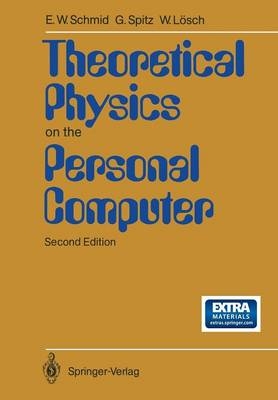
Theoretical Physics on the Personal Computer
Springer Berlin (Verlag)
978-3-642-75473-9 (ISBN)
- Titel ist leider vergriffen;
keine Neuauflage - Artikel merken
1. Introduction.- 1.1 Programming of the Numerical Portions of the Programs.- 1.2 Programming of the Input and Output.- 2. Numerical Differentiation and Introduction into Screen Dialogue.- 2.1 Formulation of the Problem.- 2.2 Mathematical Methods.- 2.3 Programming.- 2.4 Exercises.- 2.5 Solutions to the Exercises.- 3. Numerical Integration.- 3.1 Formulation of the Problem.- 3.2 Numerical Methods.- 3.2.1 The Trapezoidal Rule.- 3.2.2 The Simpson Rule.- 3.2.3 Newton-Cotes Integration.- 3.2.4 The Gauss-Legendre Integration.- 3.3 Programming.- 3.4 Exercises.- 3.5 Solutions to the Exercises.- 4. Harmonic Oscillations with Sliding and Static Friction, Graphical Output of Curves.- 4.1 Formulation of the Problem.- 4.2 Numerical Treatment.- 4.2.1 Transformation of the Differential Equation.- 4.2.2 The Euler Method.- 4.3 Programming.- 4.4 Exercises.- 4.5 Solutions to the Exercises.- 5. Anharmonic Free and Forced Oscillations.- 5.1 Formulation of the Problem.- 5.2 Numerical Treatment.- 5.2.1 Improvement of the Euler Method.- 5.2.2 The Runge-Kutta Method.- 5.3 Programming.- 5.4 Exercises.- 5.5 Solutions to the Exercises.- 6. Coupled Harmonic Oscillations.- 6.1 Formulation of the Problem.- 6.2 Numerical Method.- 6.3 Programming.- 6.4 Exercises.- 6.5 Solutions to the Exercises.- 7. The Flight Path of a Space Craft as a Solution of the Hamilton Equations.- 7.1 Formulation of the Problem.- 7.2 Mathematical Methods.- 7.2.1 Mesh Width Adaptation in the Runge-Kutta Method.- 7.2.2 Coordinate Transformation.- 7.3 Programming.- 7.3.1 Hamilton’s Equations of Motion.- 7.3.2 Automatic Mesh Width Adjustment in the Runge-Kutta Method.- 7.3.3 Coordinate Transformation.- 7.3.4 Main Program.- 7.4 Exercises.- 7.5 Solutions to the Exercises.- 8. The Celestial Mechanics Three-body Problem.- 8.1 Formulation of the Problem.- 8.2 Mathematical Method.- 8.3 Programming.- 8.4 Exercises.- 8.5 Solutions to the Exercises.- 9. Computation of Electric Fields by the Method of Successive Over-relaxation.- 9.1 Formulation of the Problem.- 9.2 Numerical Method.- 9.2.1 Discretisation of Laplace’s Equation.- 9.2.2 The Method of Successive Over-relaxation.- 9.3 Programming.- 9.4 Exercises.- 9.5 Solutions to the Exercises.- 10. The Van der Waals Equation.- 10.1 Formulation of the Problem.- 10.2 Numerical Method.- 10.3 Programming.- 10.4 Exercises.- 10.5 Solutions to the Exercises.- 11. Solution of the Fourier Heat Conduction Equation and the “Geo-Power Station”.- 11.1 Formulation of the Problem.- 11.2 Method of Solution.- 11.3 Programming.- 11.4 Exercises.- 11.5 Solutions to the Exercises.- 12. Group and Phase Velocity in the Example of Water Waves.- 12.1 Formulation of the Problem.- 12.2 Numerical Method.- 12.3 Programming.- 12.4 Exercises.- 12.5 Solutions to the Exercises.- 13. Solution of the Radial Schrödinger Equation by the Fox-Goodwin Method.- 13.1 Formulation of the Problem.- 13.2 Numerical Method of Solution.- 13.3 Programming.- 13.4 Exercises.- 13.5 Solutions to the Exercises.- 14. The Quantum Mechanical Harmonic Oscillator.- 14.1 Formulation of the Problem.- 14.2 Numerical Method.- 14.3 Programming.- 14.4 Exercises.- 14.5 Solutions to the Exercises.- 15. Solution of the Schrödinger Equation in Harmonic Oscillator Representation.- 15.1 Formulation of the Problem.- 15.2 Numerical Method.- 15.3 Programming.- 15.4 Exercises.- 15.5 Solutions to the Exercises.- 16. The Ground State of the Helium Atom by the Hylleraas Method.- 16.1 Formulation of the Problem.- 16.2 Setting up the State Basis and the Matrix Equation.- 16.3 Programming.- 16.4 Exercises.- 16.5 Solutions to the Exercises.- 17. The Spherical Harmonics.- 17.1 Formulation of the Problem.- 17.2 Numerical Method.- 17.3 Programming.- 17.4 Exercises.- 17.5 Solutions to the Exercises.- 18. The Spherical Bessel Functions.- 18.1 Formulation of the Problem.- 18.2 Mathematical Method.- 18.3 Programming.- 18.4 Exercises.- 18.5 Solutions to the Exercises.- 19. Scattering of an Uncharged Particle from a Spherically Symmetric Potential.- 19.1 Formulation of the Problem.- 19.2 Mathematical Treatment of the Scattering Problem.- 19.3 Programming.- 19.4 Exercises.- 19.5 Solutions to the Exercises.- References.
| Übersetzer | A.H. Armstrong |
|---|---|
| Zusatzinfo | XIV, 213 p. |
| Verlagsort | Berlin |
| Sprache | englisch |
| Maße | 170 x 242 mm |
| Gewicht | 404 g |
| Themenwelt | Naturwissenschaften ► Physik / Astronomie ► Allgemeines / Lexika |
| Schlagworte | Applied mathematics • Bessel function • differential equation • Group • Mathematics • Mechanics • numerical method • Physics • Potential • programming • scattering • Solution • Structure • theoretical physics • Three-body problem |
| ISBN-10 | 3-642-75473-2 / 3642754732 |
| ISBN-13 | 978-3-642-75473-9 / 9783642754739 |
| Zustand | Neuware |
| Haben Sie eine Frage zum Produkt? |
aus dem Bereich


